

31 Pedagogical Techniques That Every Teacher Should Have in Their Toolkits. When it comes to teaching, your technique is everything.
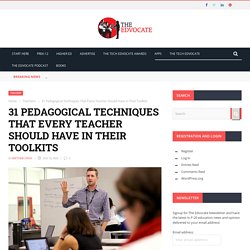
Knowing what techniques and strategies to employ and when to use them, can mean the difference a student succeeding academically or experiencing academic failure. That is why it is important for all teachers to have a toolkit full of research-based pedagogical techniques that they can implement at a moments notice. If you want to know what techniques you should place in your toolkit, keep reading. In this piece, we will discuss 31 pedagogical techniques that every teacher should have in their toolkit. 1. 2. 32 Research-Based Instructional Strategies - 32 Research-Based Instructional Strategies by TeachThought Staff You want to teach with what’s been proven to work.

That makes sense. In the ‘data era’ of education that’s mean research-based instructional strategies to drive data-based teaching, and while there’s a lot to consider here we’d love to explore more deeply, for now we’re just going to take a look at the instructional strategies themselves. A post is not the best way to share this kind of information, honestly. A Paper on Educational Approaches.
Approaches to Classroom Assessment Inventory. The purpose of this survey is to determine your approach to classroom assessment.

At the end of the survey, an 'assessment profile' will be generated for you, which will give you a better understanding of your strengths and areas for learning in classroom assessment. The survey uses a scenario-based question design to help analyze your approach to classroom assessment. Given this format, there are no correct answers. Rather, you are asked to select your ideal response to each assessment scenario based on your own teaching context. This format also provides a basis for professional conversations about assessment. Assessment FOR Learning. Authentic Student Learning. Bloom. Boredom and Its Opposite. Brain-Based Learning.
Cognitive Constructivism. Cognitivist teaching methods aim to assist students in assimilating new information to existing knowledge, and enabling them to make the appropriate modifications to their existing intellectual framework to accommodate that information.

BackgroundView of KnowledgeView of LearningView of MotivationImplications for TeachingJean PiagetWilliam G. PerryReferences Background. Cognitive Load Theory and the Format of Instruction. Cognitive Load Theory and Instructional Design. Constructivism (common misunderstandings) Summary: Constructivism as a paradigm or worldview posits that learning is an active, constructive process.
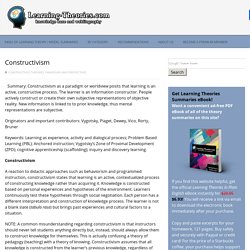
The learner is an information constructor. People actively construct or create their own subjective representations of objective reality. New information is linked to to prior knowledge, thus mental representations are subjective. Originators and important contributors: Vygotsky, Piaget, Dewey, Vico, Rorty, Bruner. Cooperative Learning Activities. Deep and Surface Learning. Differentiating Instruction. Within the four ways for differentiating instruction there are embedded several other learning strategies which are used in conjunction with each other.
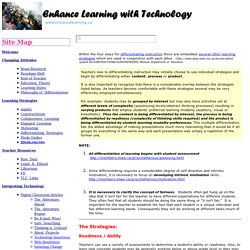
The Strategies: Readiness / Ability Teachers can use a variety of assessments to determine a student's ability or readiness. Also, to learn new concepts students may be generally working below or above grade level or they may simply be missing necessary prerequisite skills. Differentiation Guide. Differentiated Instruction Brochure. Differentiated Learning. Feedback for Learning.
Fixed Mindset. Formative Assessment. Free Audience and Student Response System. Growth Mindset. Helping All Learners: Tiering. Helping Shy Students. All teachers have had shy students in their classroom.

These children are the ones who keep to themselves and quietly complete their work, often hiding from the attention of the teacher or their classmates. However, some of these children are not just shy or quiet but may have social anxiety disorder. For these students, simply going to school everyday and interacting with other children and adults makes them feel extremely anxious. They are excessively shy, have an intense fear of social and performance situations, and are concerned about humiliation or embarrassment. Anxiety may be excessive enough that anticipation of a social event may provoke a panic attack or cause intense distress. How do teachers know if a student is suffering from social anxiety? How to Write Rationale. Human Figure Drawings by Gifted and Normally Developed Children at Preschool Period. Instructional Approaches Handbook. Instructional Strategies.
Instructional Strategies. Johns Hopkins University: New Horizons for Learning. Welcome to New Horizons for Learning - a leading web resource for identifying and communicating successful strategies for educational practice.
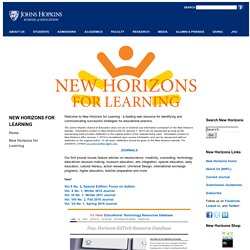
The Johns Hopkins School of Education does not vet or endorse any information contained on the New Horizons website. Information posted on New Horizons prior to January 1, 2014 can be repurposed as long as the repurposing party provides attribution to the original author of the material being used. Information posted on New Horizons after January 1, 2014 is considered open access information and can be repurposed without attribution to the original author. In all cases, attribution should be given to the New Horizons website. For questions, contact soe.externalaffairs@jhu.edu. Kagan PIES. Kagan Structures Respect Basic Principles Different Kagan structures are designed to implement different principles or visions.
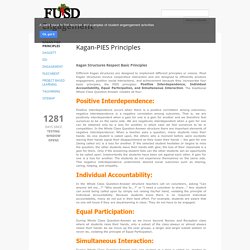
Most Kagan structures involve cooperative interaction and are designed to efficiently produce engagement, positive social interactions, and achievement because they incorporate four basic principles, the PIES principles: Positive Interdependence, Individual Accountability, Equal Participation, and Simultaneous Interaction. The traditional Whole Class Question-Answer violates all four: Positive Interdependence: Positive interdependence occurs when there is a positive correlation among outcomes; negative interdependence is a negative correlation among outcomes. Individual Accountability: In the Whole Class Question-Answer structure teachers call on volunteers, asking "Can anyone tell me...? " Learning and Assessment Framework.
Pedagogy. Standards-based Assessment. Strategies to Improve. The Association for Bright Children Ontario. The Glossary of Education Reform - The Socratic Method. Top 10 Evidence-Based Teaching Strategies. Top 10 Evidence-Based Teaching Strategies for Those Who Care About Student Results By Shaun Killian Most teachers care about their students' results, and if you are reading this article, you are undoubtedly one of them.

There is no doubt that teachers make a difference to how well their kids do at school. However, when you explore the thousands of research studies1 on the topic, it is apparent that some teaching strategies have far more impact than other teaching strategies do. Top 10 Evidence Based Teaching Strategies. Trends. Modern Trends In Education: 50 Different Approaches To Learning by Lisa Chesser, opencolleges.edu.au Education sprouts in many forms depending on how you look at it. Understanding Learners. Students learn in a variety of ways: by seeing and hearing, working alone and in groups, reasoning logically and intuitively, memorising, visualising and modelling. Some prefer pictures to texts. Others prefer concrete before abstract. Teaching methods also vary: some teachers lecture, others demonstrate or discuss; some focus on principles and others on applications; some emphasise memory and others understanding. How much students learn in a class depends, among other things, on the match between their learning style preferences and the instructor's teaching style.
An awareness of the different types of learners likely to be in your class can inform how you present material, design activities and sequence your explanations. What Is Gamification? What Makes Great Teaching?